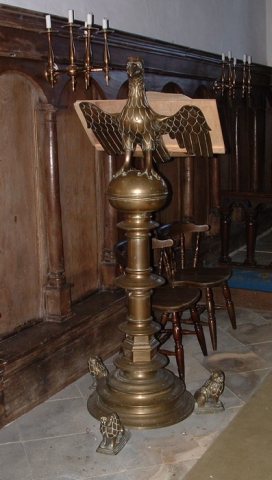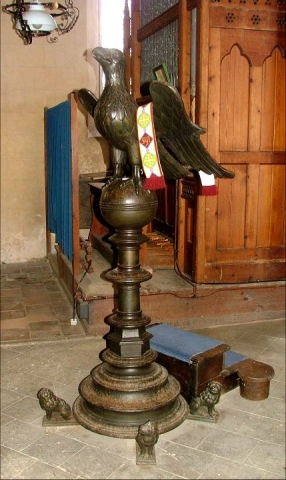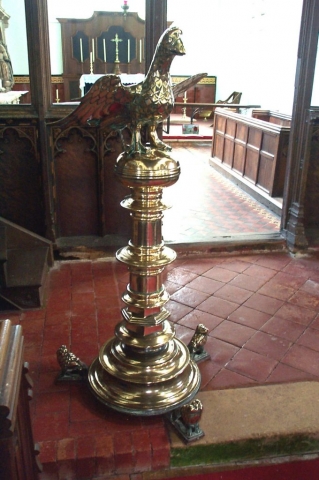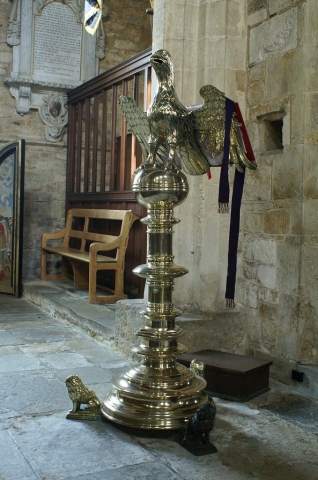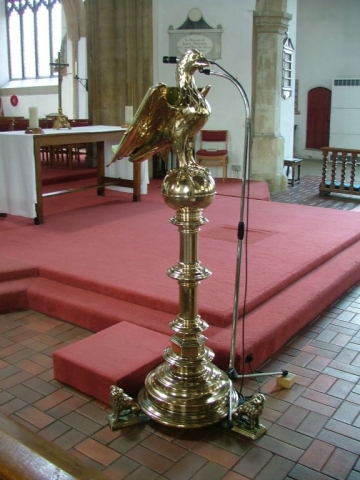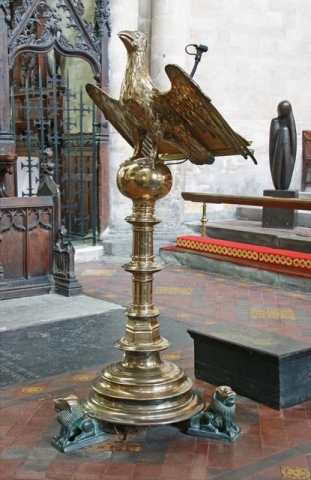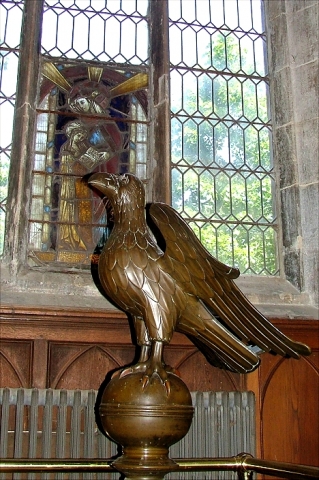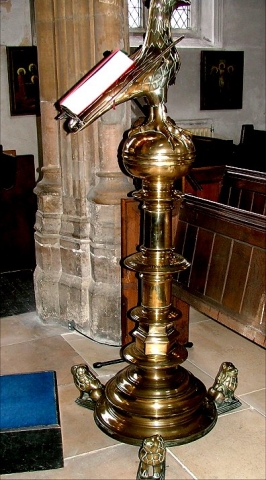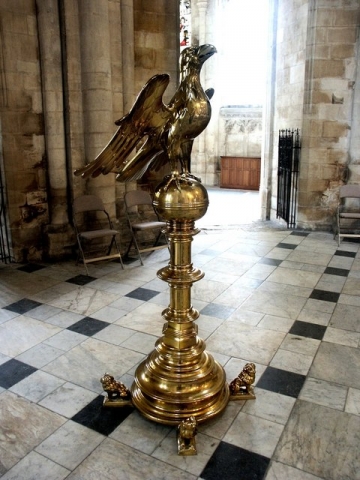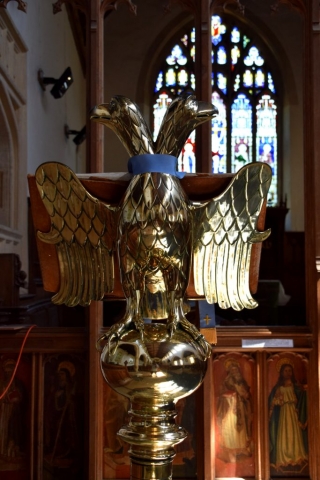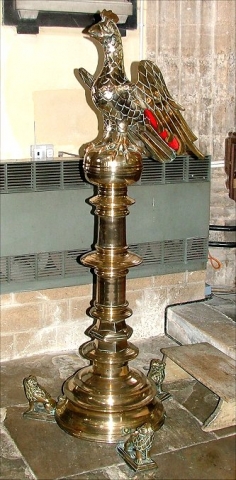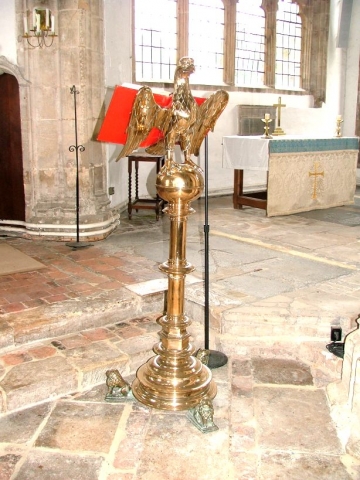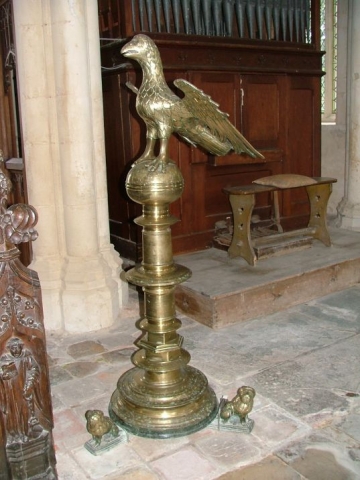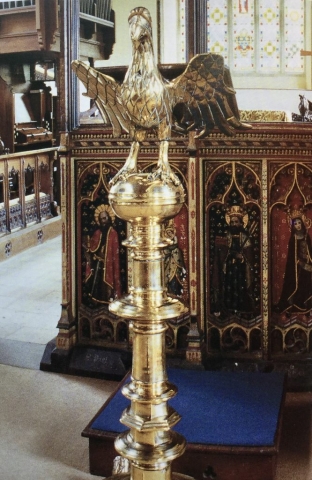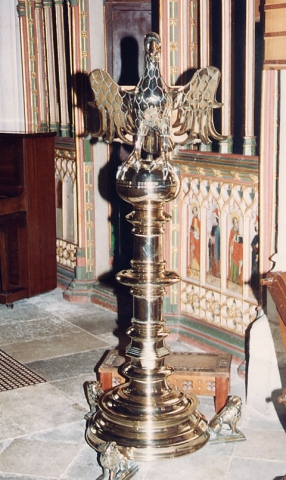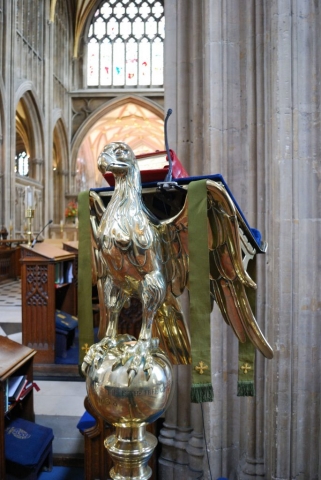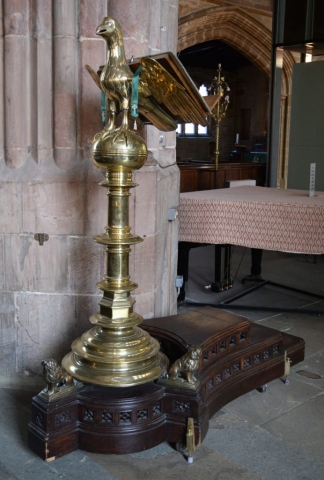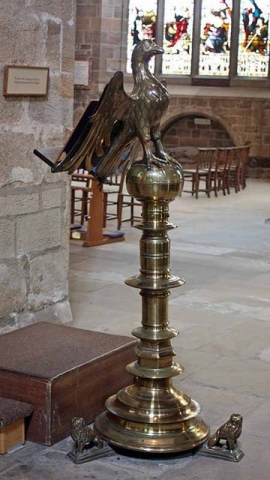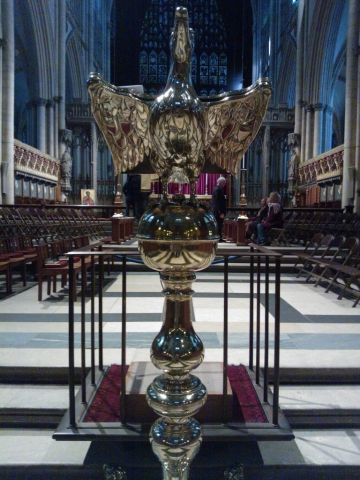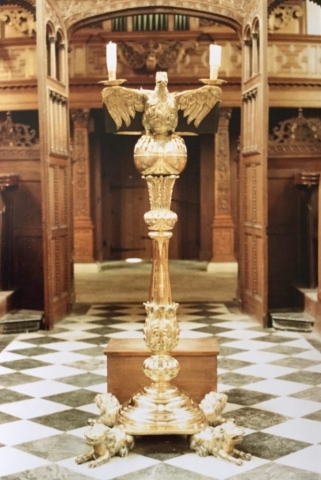The lectern at Little Gidding is one of a small number of survivors from the late Middle Ages and early Tudor period (up to the Reformation). There remain some 40 or 50 English mediaeval brass eagle lecterns, including the one at Little Gidding. Over half are in the east of the country (Norfolk, Suffolk, Essex, Lincolnshire, Cambridgeshire and Huntingdonshire), and Oman (1930) hypothesized an origin in this area, perhaps Norwich or Bury St Edmunds. Van der Meulen in 2018 indicated a preference for Flanders.
These lecterns were made from standard patterns carved in wood which were reused in various combinations. Typically there are a dozen or so components, including the body of the eagle, the wings, the talons, the globe, the various cylinders and mouldings of the pedestal, and the seated lions that act as the feet. These components can be assembled in different groups, for example different bodies with the same wings, or with different lions. By classifying the various styles of the components it is possible to group the lecterns into a number of families.
Billingford | Cavendish | Dereham St Nicholas | Kings Lynn St Nicholas | Kings Lynn St Margaret | Norwich St Giles |
- Medieval Brass Lecterns in England (The Archaeological Journal, Volume 87 (1930) pp 117-149) C. C. Oman, M.A.
- English Brass Lecterns of the Seventeenth and Eighteenth Centuries (The Archaeological Journal, Volume 88 (1931) pp 218-227) C. C. Oman
- Brass Eagle Lecterns in England Marcus van der Meulen
- The Brass Eagle Lecterns of England, Marcus van der Meulen, Amberley Publishing, 2017, ISBN 978-1-4456-6820-8
- My last word on late-medieval brass eagle lecterns Jonathan Russell
- Conservation work for the lectern at Oxborough St John by Rupert Harris Conservation, who also undertook the 2019 restoration of the Little Gidding lectern
In his 1930 paper, Charles Oman (1901-82), who was Keeper of the Department of Metalwork at the Victoria and Albert Museum, classified the mediaeval brass lecterns known to him according to the styles of the different components, dividing them into four “series”, I, II, III and IV, with Series III being subdivided into five groups, according to the body shape. Group V of Series III, and the sole lectern in Series IV are desk lecterns rather than Eagle lecterns, so are not further considered here. In his 1931 paper he adds a further 13 post-Reformation examples. Van der Meulen (2017) lists 53 brass eagle lecterns, ignoring those outside England, and the non-eagle ones, and continuing after the Reformation up to 1731, after which newer brassfounding techniques and mass-production were introduced. The list below follows Oman’s order, with his numbers prefixed by the letter C, and with Van der Meulen’s numbers in square brackets against Oman’s list, prefixed by the letter M.
Series I 
- Peterborough Cathedral [M-24]
- Billingford, Norfolk [M-38]
- King’s Lynn, St Nicholas [M-26]
Thorverton, Devonin a subsequent article Oman notes that this is a 19th-century copy- Isleham, Cambridgeshire [M-27]
- Venice, St Mark’s
- Cambridge, Christ’s College [M-32]
Series II 
- Clare, Suffolk [M-22]
- Redenhall, Norfolk [M-23]
- King’s Lynn, St Margaret [M-18]
Series III 
Group I
- Oxborough, Norfolk [M-16]
- Lowestoft [M-09]
- Coventry, Holy Trinity [M-06]
- Wolborough, Devon [M-07]
- Norwich, St Gregory
- Oundle [M-04]
- Little Gidding, Huntingdonshire [M-10]
- Southwell Cathedral [M-13]
- Urbino Cathedral
- St Albans, St Stephen (currently in Edinburgh)
- Long Sutton, Lincolnshire [M-03]
- Southampton, St Michael [M-08]
- Newcastle Cathedral [M-14]
Group II
- Bovey Tracey, Devon [M-33]
- Bristol, St Nicholas
- Salisbury, St Martin [M-12]
- Croydon [M-29]
- Wiggenhall, St Mary the Virgin, Norfolk [M-36]
- Cropredy, Oxfordshire [M-05]
Group III
- Croft, Lincolnshire [M-34]
- Wrexham
- Woolpit, Suffolk [M-38]
- Cavendish, Suffolk [M-31]
- Upwell, Norfolk [M-28]
- Chipping Campden, Gloucestershire [M-40]
- Oxford, Corpus Christi College
Group IV
- East Dereham, Norfolk [M-25]
- Snettisham, Norfolk [M-30]
- Walpole St Peter, Norfolk [M-21]
- Exeter Cathedral [M-20]
Group V (double reading desk, no eagle)
- Cambridge, King’s College
- Eton College
- Oxford, Merton College
Series IV (double reading desk, no eagle)
- Yeovil
In his subsequent paper in 1931, Oman listed the brass lecterns of the 17th and 18th centuries, leaving them unnumbered and, except in the text, ungrouped. These lecterns were made in England, using the same techniques as the earlier ones, but with different patterns. The grouping is here inferred from Oman’s text, with the C-numbers continued in sequence from the 1930 paper. For these lecterns the date of manufacture and very often the founder is known, and they are ordered by date, except for Brasenose College (which though dated the latest is grouped with Bristol Cathedral and York Minster).
Series V 
- Wimborne Minster, Dorset, 1623 [M-42]
Series VI 
- Oxford, Magdalen College, 1633 [M-43]
- Oxford, Exeter College, 1637 [M-44]
- Bristol, St Mary Redcliffe, 1638 [M-45]
Series VII 
- Oxford, Queen’s College, 1662 [M-46]
- Canterbury Cathedral, 1663 [M-47]
- Lincoln Cathedral, 1667 [M-48]
- Wells Cathedral, 1670-72
Series VIII 
- Bristol, St John-on-the-Wall (made for Bristol Cathedral), 1683 [M-49]
- York Minster, 1686 [M-50]
- Oxford, Brasenose College, 1731 [M-53]
Series IX 
- Oxford, Wadham College, 1691 [M-51]
Series X 
- St Paul’s Cathedral, 1719 [M-52]
Van der Meulen adds the following mediaeval and early Tudor lecterns:
M-01 Southampton, St Michael (formerly Holy Rood)
M-02 Norwich, St Giles
M-11 Wells-next-the-Sea, Norfolk
M-15 Bristol, St Stephen
M-17 Oxford, Balliol College
M-19 Petworth, West Sussex, Petworth House Chapel
M-35 Outwell, Norfolk
M-39 City of London, St Bride
M-41 Norwich Cathedral (pelican)

